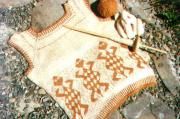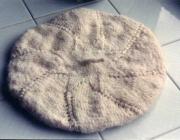About Connie
I first learned to knit and crochet under the tender tutelage of my mother and grandmother. I remember loving the feel of the yarn clicking through the needles, but never being brave enough to actually wear anything I made because it looked so fake. Then I discovered wool yarn. I was immediately in love with natural fibers and have not touched acrylic since.
I discovered handspinning in the late 70's. I spun my first beginner's yarn on a wheel at a friend's house and was immediately addicted. Knowing I couldn't afford a spinning wheel of my own, and frustrated with trying to pedal and draft at the same time, I got a handspindle and taught myself to spin. I then built a spinning wheel for myself out of an old bicycle wheel. Even though it clunked vigorously as I spun, I had great speed on it and started a small business spinning yarn to sell.
My biggest problem with my yarn was in making garments that actually fit people. So I began devising methods of creating garments with easy shapes that I could change to whatever gauge I happened to get with my handspun yarn.
In the early 90's I tried to publish some of my patterns in national knitting magazines and discovered that they wanted nothing to do with my design and calculation techniques. I wanted nothing to do with their set gauge techniques.
There was only one thing to do.
I began publishing my own patterns in a subscription newsletter which I initially wanted to call The Handspinner's Craft Pattern Newsletter, but shortened to SpinCraft Pattern Newsletter. To date I have published over 100 patterns and haven't begun to run out of ideas.
SpinCraft is a small business run by the author. Even though I realize we are working in competition with large corporations, I intend to keep it small, homespun, and simple.
When you get a SpinCraft pattern you get a little bit of hand made creativity in this world of high-tech commerce. Most of my readers seem to appreciate the simplicity in reading and understanding my patterns.
WEAVING

Like most handspinners, I am also addicted to weaving. Unfortunately (for my weaving skills) I live in a very small house and could never afford, or fit, a large, expensive loom. To make up for that I have used a small Louet 4-harness loom, and lots of little rigid heddle looms. I used to drive myself crazy wanting a big loom so that I could design weaving patterns until, all the sudden one day, I realized that I am not alone in the world. Most of us fiber addicts cannot afford a big loom or ever hope to fit one in our houses! And yet, most weaving patterns are written for giant, expensive looms. So I decided to specialize in fun things that simple people, like myself, can do on their little looms.
KNITTING MACHINES:
I have the same attitude about knitting machines as I have about looms. I would love to have a thirty thousand dollar knitting machine hooked up to my computer, but it is never going to happen. Instead, I have an old-timey, bulky knitting machine that doesn't even have a ribber. It has grooves worn in the bed from the pressure of running my handspun yarn through it's needles.
Sometimes I like to knit on it, but most the time I prefer to snuggle up on my couch with a good video and knit mindlessly and happily away with my hands.
When I design patterns that can work on a knitting machine they are really nothing more than an interesting shape which can be done easily on the machine. I know that my patterns will work on anybody's machine.
My machine designs are like a blank pallet on which the real knitting machine guru's can paint their gorgeous pictures.




